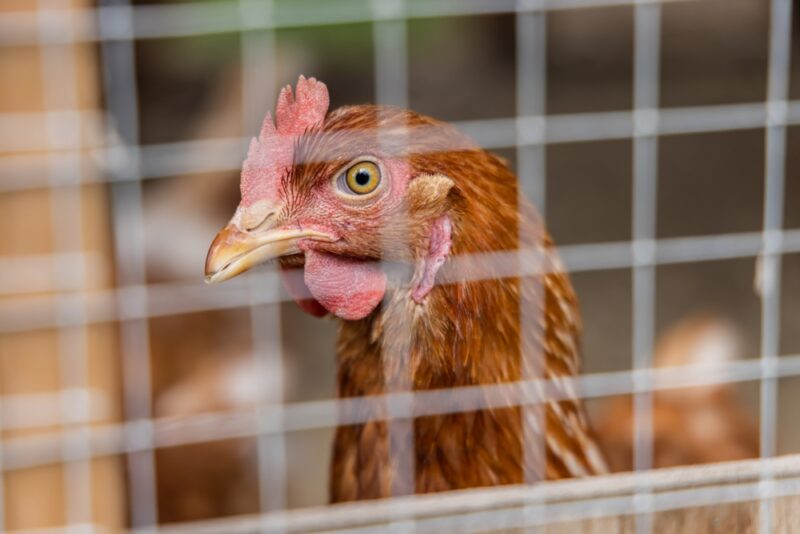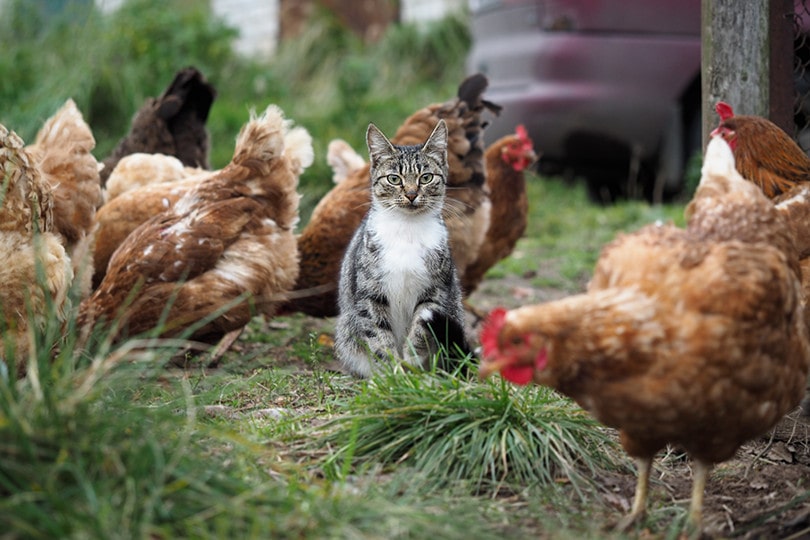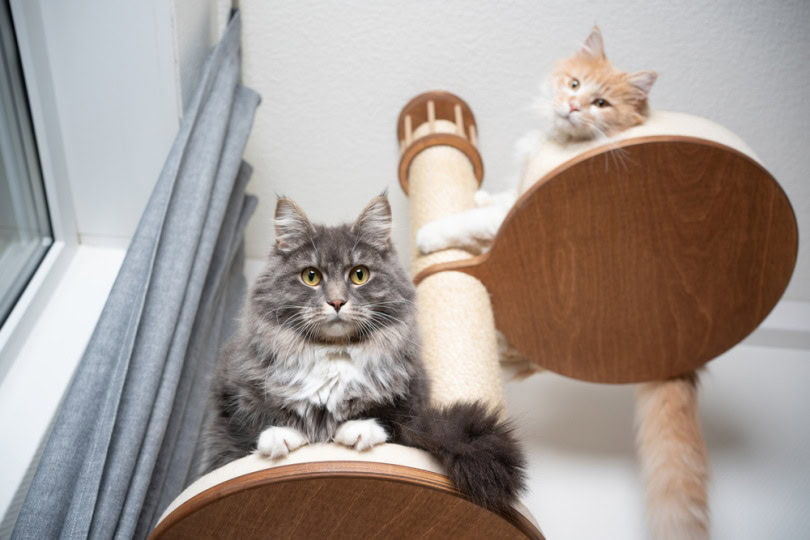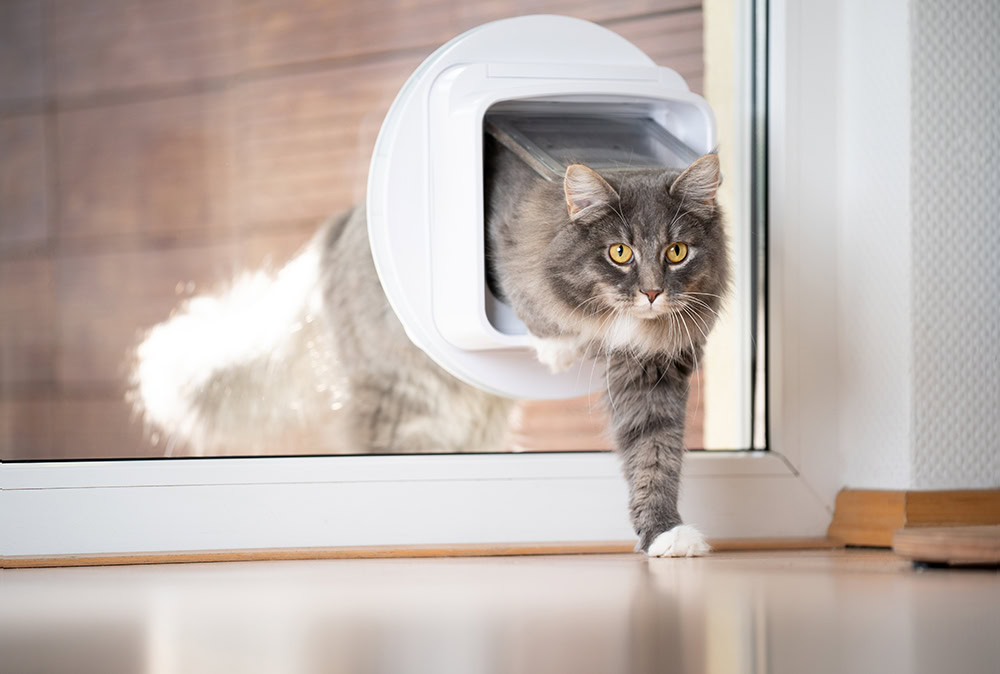Click to Skip Ahead
Considering the increasing number of people that are keeping chickens in their backyards, it should come as no surprise that many people wonder how to introduce cats and chickens to each other.
Maybe you’re planning on keeping some free-range chickens on your property and wonder how to safely introduce your pet cat to the chickens.1 Or perhaps you already have chickens and want to get a cat. Either way, it’s important that they get along to avoid lots of trouble including injuries or worse.
While cats and chickens don’t seem like good roomies, they can learn to live in harmony if you introduce them correctly. To avoid creating problems wherein feathers and fur will fly, here are some dos and don’ts to follow when introducing your cat and chickens to each other.

The Dos & Don’ts When Introducing Cats to Chickens
1. Do It When They’re Young
Compared to full-grown animals, young chickens and cats find it easier to adapt to new animals, surroundings, and situations. If possible, introduce your cat and chickens to each other while they’re young to get them used to one another. However, do not introduce an adult cat to young chicks, as they may see them as prey.
2. Don’t Rush Things
Instead of hurrying to get your cat and chickens used to each other, take your time. Your chances for a successful meetup will be better if you go slowly. Remain calm and composed, praise your cat for relaxed behavior, and never raise your voice, as this is likely to only scare the animals, causing the chickens to try and run off, which may set off the cat’s hunting instincts..
3. Do Use a Wire Mesh Fence as a Barrier
When introducing your cat to your chickens for the first few times, do it through the safety of a wire mesh fence. This way, if the introduction goes sour, both your cat and your chickens will be safe.

4. Do Not Attempt a Face-to-Face Meeting
Don’t allow your cat to get face to face with your chickens until you’re sure they won’t attack. Practice with the wire mesh fence for days or weeks, sometimes longer, and observe your cat’s body language. If your cat shows predatory instincts, distract them with a toy or sound, and redirect their attention to something else before trying again. Also, keep in mind your cat’s temperament, as for some cats that are hunters, it may be more challenging to accept chickens, while others may not be interested in the chickens in the first place.
5. Slowly Extend The Time They Spend Around Each Other
Once your cat is exhibiting calm behavior without showing any predatory instincts and your chickens aren’t afraid, let them be around each other for short periods while keeping a close eye on things. Still, make sure there is a wire mesh fence between them at this stage. It’s a good idea to have a cat toy for your feline to play with so they don’t obsess over the chickens or suddenly decide they’d make good prey.
6. Don’t Leave Them Unsupervised
After a while, if all is going well, you can try and let the animals interact without the fence between them, but acknowledge the risk that will unfortunately always be present. It will take a good deal of time for your cat and chickens to coexist safely, so you should not leave them alone unsupervised. It only takes a sudden movement from a chicken to trigger a cat. Even if you think you know your cat very well and trust them, these types of interactions are often unpredictable and may lead to injuries to both animals.

What to Do If You Don’t Have Time for Training
If you don’t have weeks or months to spend training your cat and chickens to coexist peacefully, don’t worry! Another solution to the cat and chicken problem is to build a run enclosure onto your chicken coop. This will allow your chickens some extra space to roam free while keeping a barrier between them and your cat.
How Cats Behave Around Chickens
You may be surprised to learn that some cats tend to be afraid of chickens because of their size. Of course, there are cases where cats have attacked and killed chickens, but it’s not all that usual.
Things are a little different with young chicks as they’re not so scary to cats. If you were to leave a young chick alone with a cat, the chick may not fare well. If you have chicks now and then, be careful not to let them around your cat when you’re not nearby because you just never know!
Generally speaking, cats are curious and standoffish when meeting chickens for the first time. Remember that chickens are not the type of birds cats go after in the wild as they’re simply too large for most cats to deal with.
- See Also: How to Introduce a Cat to a Dog (8 Tips)
Chickens Can Make Cats Sick
It’s important to know that cats can get Salmonella infection from ingesting chicken feces and raw eggs. If your cat were to get Salmonella, they could carry and spread the bacteria without showing any signs of illness, while some cats may suffer from vomiting, diarrhea, lethargy, poor appetite, fever, and others. This is why it’s important to keep your coop and yard clean and prevent your cat from eating or drinking in areas where your chickens roam.


Conclusion
Cats and chickens can coexist if you have the time and patience to train your animals to get along. The key is to take your time so your cat and your flock can get used to each other. For the best results, follow the advice above and be patient! Before you know it, your cat and chickens will be living in sweet harmony!
Featured Image Credit: Irina Kozorog, Shutterstock










